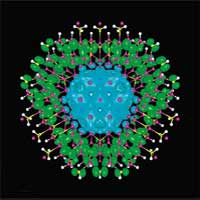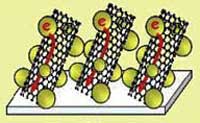Showing Spotlights 73 - 77 of 77 in category All (newest first):
 Nanowires have received a great deal of interest in recent years. As quasi one-dimensional systems they may overcome the fundamental difficulty in the electronic transport encountered when attempting to use quasi zero-dimensional structures (quantum dots) while still being able to take advantage of the effects related to quantum confinement. In a conventional semiconductor, electrons and holes typically stay in the same region after photoexcitation, which is very desirable for certain applications, light-emitting devices for instance. However, for a number of key renewable energy applications, including hydrogen generation via photoelectrochemical water splitting, dye-sensitized solar cells, and even regular solar cells, the efficient charge separation of the electron and hole after photoexcitation is instead highly preferred, although not readily available in the existing repertory of materials. In this context, researchers have explored the use of core-shell nanowires for such applications. However, for the material combinations that have been investigated, the energy alignments between the core and the shell are typically type I, and thus, the role of the shell is to either provide quantum confinement to both electrons and holes in the core or a protective cladding to the core to reduce sensitivity to the environment. Researchers at the National Renewable Energy Laboratory and Lawrence Berkeley National Laboratory designed a new class of core-shell semiconductor nanowires with strong type II band alignments. The photo-generated electron and hole in such nanowires are naturally separated in the core and shell, respectively, making them much more suitable for the solar energy applications than type I core-shell nanowires.
Nanowires have received a great deal of interest in recent years. As quasi one-dimensional systems they may overcome the fundamental difficulty in the electronic transport encountered when attempting to use quasi zero-dimensional structures (quantum dots) while still being able to take advantage of the effects related to quantum confinement. In a conventional semiconductor, electrons and holes typically stay in the same region after photoexcitation, which is very desirable for certain applications, light-emitting devices for instance. However, for a number of key renewable energy applications, including hydrogen generation via photoelectrochemical water splitting, dye-sensitized solar cells, and even regular solar cells, the efficient charge separation of the electron and hole after photoexcitation is instead highly preferred, although not readily available in the existing repertory of materials. In this context, researchers have explored the use of core-shell nanowires for such applications. However, for the material combinations that have been investigated, the energy alignments between the core and the shell are typically type I, and thus, the role of the shell is to either provide quantum confinement to both electrons and holes in the core or a protective cladding to the core to reduce sensitivity to the environment. Researchers at the National Renewable Energy Laboratory and Lawrence Berkeley National Laboratory designed a new class of core-shell semiconductor nanowires with strong type II band alignments. The photo-generated electron and hole in such nanowires are naturally separated in the core and shell, respectively, making them much more suitable for the solar energy applications than type I core-shell nanowires.
Apr 20th, 2007
 The photocatalytic activity of nanostructured semiconductor films has been widely explored in designing solar cells, solar hydrogen production, and environmental remediation. Of particular interest is the dye-sensitized solar cell (DSSC) which uses nanostructured titanium dioxide films modified with sensitizing dyes. Despite the initial success of achieving 10% solar conversion efficiency, the effort to further improve their performance has not been very successful. A major hurdle in attaining higher photoconversion efficiency in such nanostructured electrodes is the transport of electrons across the particle network. The photogenerated electrons in nanostructured films for example have to travel through the network of semiconductor particles and encounter many grain boundaries during the transit. Such a random transit path for the photogenerated electrons increases the probability of their recombination with oxidized sensitizer. With the recent advance in the design of nanotube and nanowire architecture, it should be possible to use such one-dimensional nanostructures to direct the flow of photogenerated charge carriers. The obvious challenge is to use nanowire or nanotube networks as support to anchor light-harvesting semiconductor particles and facilitate the electron transport to the collecting electrode surface in a solar cell. Researchers now have demonstrated that single wall carbon nanotube (SWCNT) architecture when employed as conducting scaffolds in a titanium dioxide semiconductor based photoelectrochemical cell can boost the photoconversion efficiency by a factor of 2.
The photocatalytic activity of nanostructured semiconductor films has been widely explored in designing solar cells, solar hydrogen production, and environmental remediation. Of particular interest is the dye-sensitized solar cell (DSSC) which uses nanostructured titanium dioxide films modified with sensitizing dyes. Despite the initial success of achieving 10% solar conversion efficiency, the effort to further improve their performance has not been very successful. A major hurdle in attaining higher photoconversion efficiency in such nanostructured electrodes is the transport of electrons across the particle network. The photogenerated electrons in nanostructured films for example have to travel through the network of semiconductor particles and encounter many grain boundaries during the transit. Such a random transit path for the photogenerated electrons increases the probability of their recombination with oxidized sensitizer. With the recent advance in the design of nanotube and nanowire architecture, it should be possible to use such one-dimensional nanostructures to direct the flow of photogenerated charge carriers. The obvious challenge is to use nanowire or nanotube networks as support to anchor light-harvesting semiconductor particles and facilitate the electron transport to the collecting electrode surface in a solar cell. Researchers now have demonstrated that single wall carbon nanotube (SWCNT) architecture when employed as conducting scaffolds in a titanium dioxide semiconductor based photoelectrochemical cell can boost the photoconversion efficiency by a factor of 2.
Feb 28th, 2007
 With an increased focus on alternative sources of cheap, abundant, clean energy, solar cells are receiving lots of attention. Harnessing the power of the sun to replace the use of fossil fuels holds tremendous promise. One way to do this is through the use of solar, or photovoltaic, cells. Until now, solar cells that convert sunlight to electric power have been dominated by solid state junction devices, often made of silicon wafers. Thanks to nanotechnology, this is now being challenged by the development of a new generation of solar cells based on thin film materials, nanocrystalline materials and conducting polymeric films. These offer the prospects of cheaper materials, higher efficiency and flexible features. This has opened up new opportunities in solar cell research and development and, consequently, there is considerable investor interest in solar nanotechnology startups. Both inventors and investors are betting that flexible sheets of solar cells used to harness the sun's strength will ultimately provide a cheap and efficient source of energy.
With an increased focus on alternative sources of cheap, abundant, clean energy, solar cells are receiving lots of attention. Harnessing the power of the sun to replace the use of fossil fuels holds tremendous promise. One way to do this is through the use of solar, or photovoltaic, cells. Until now, solar cells that convert sunlight to electric power have been dominated by solid state junction devices, often made of silicon wafers. Thanks to nanotechnology, this is now being challenged by the development of a new generation of solar cells based on thin film materials, nanocrystalline materials and conducting polymeric films. These offer the prospects of cheaper materials, higher efficiency and flexible features. This has opened up new opportunities in solar cell research and development and, consequently, there is considerable investor interest in solar nanotechnology startups. Both inventors and investors are betting that flexible sheets of solar cells used to harness the sun's strength will ultimately provide a cheap and efficient source of energy.
Feb 22nd, 2007
 A group of Chinese researchers prepared dye-sensitized solar cells using micro/nanocomposite TiO2 porous films, resulting in cells with enhanced light collection. They applied a technique which can produce a large area in continuous fabrication. This technique opens an alternative way for manufacturing solar cells on an industrial scale.
A group of Chinese researchers prepared dye-sensitized solar cells using micro/nanocomposite TiO2 porous films, resulting in cells with enhanced light collection. They applied a technique which can produce a large area in continuous fabrication. This technique opens an alternative way for manufacturing solar cells on an industrial scale.
Apr 6th, 2006
 With an increased focus on alternative sources of cheap, abundant, clean energy, solar cells are receiving lots of attention. The dye sensitized solar cell (DSSC) is one of the most important developments in photovoltaics in the last two decades. Researchers are now on the brink of improving the efficiency of DSSC through nanowires.
With an increased focus on alternative sources of cheap, abundant, clean energy, solar cells are receiving lots of attention. The dye sensitized solar cell (DSSC) is one of the most important developments in photovoltaics in the last two decades. Researchers are now on the brink of improving the efficiency of DSSC through nanowires.
Mar 6th, 2006
 Nanowires have received a great deal of interest in recent years. As quasi one-dimensional systems they may overcome the fundamental difficulty in the electronic transport encountered when attempting to use quasi zero-dimensional structures (quantum dots) while still being able to take advantage of the effects related to quantum confinement. In a conventional semiconductor, electrons and holes typically stay in the same region after photoexcitation, which is very desirable for certain applications, light-emitting devices for instance. However, for a number of key renewable energy applications, including hydrogen generation via photoelectrochemical water splitting, dye-sensitized solar cells, and even regular solar cells, the efficient charge separation of the electron and hole after photoexcitation is instead highly preferred, although not readily available in the existing repertory of materials. In this context, researchers have explored the use of core-shell nanowires for such applications. However, for the material combinations that have been investigated, the energy alignments between the core and the shell are typically type I, and thus, the role of the shell is to either provide quantum confinement to both electrons and holes in the core or a protective cladding to the core to reduce sensitivity to the environment. Researchers at the National Renewable Energy Laboratory and Lawrence Berkeley National Laboratory designed a new class of core-shell semiconductor nanowires with strong type II band alignments. The photo-generated electron and hole in such nanowires are naturally separated in the core and shell, respectively, making them much more suitable for the solar energy applications than type I core-shell nanowires.
Nanowires have received a great deal of interest in recent years. As quasi one-dimensional systems they may overcome the fundamental difficulty in the electronic transport encountered when attempting to use quasi zero-dimensional structures (quantum dots) while still being able to take advantage of the effects related to quantum confinement. In a conventional semiconductor, electrons and holes typically stay in the same region after photoexcitation, which is very desirable for certain applications, light-emitting devices for instance. However, for a number of key renewable energy applications, including hydrogen generation via photoelectrochemical water splitting, dye-sensitized solar cells, and even regular solar cells, the efficient charge separation of the electron and hole after photoexcitation is instead highly preferred, although not readily available in the existing repertory of materials. In this context, researchers have explored the use of core-shell nanowires for such applications. However, for the material combinations that have been investigated, the energy alignments between the core and the shell are typically type I, and thus, the role of the shell is to either provide quantum confinement to both electrons and holes in the core or a protective cladding to the core to reduce sensitivity to the environment. Researchers at the National Renewable Energy Laboratory and Lawrence Berkeley National Laboratory designed a new class of core-shell semiconductor nanowires with strong type II band alignments. The photo-generated electron and hole in such nanowires are naturally separated in the core and shell, respectively, making them much more suitable for the solar energy applications than type I core-shell nanowires.
 Subscribe to our Nanotechnology Spotlight feed
Subscribe to our Nanotechnology Spotlight feed

